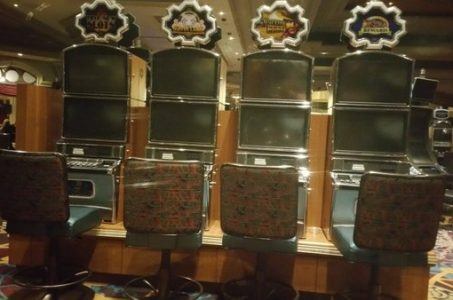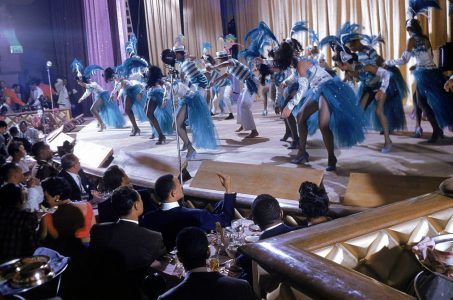Las Vegas Casinos Can Restore Magic of Earlier Era by Reconnecting With Customers: Gaming Expert
Posted on: December 6, 2020, 01:05h.
Last updated on: June 30, 2021, 08:56h.
By getting back to “personalized attention,” Las Vegas casinos can recapture the magic that defined the famous Rat Pack era from decades ago, says a gaming historian.

David G. Schwartz told Casino.org the personal attention that smaller casinos like the now-demolished Sands provided on the Las Vegas Strip are harder for the larger resorts of today. The Sands began in the 1950s with 200 rooms before expanding to 777 rooms. Newer resorts have thousands of hotel rooms.
With technological advances, however, “It may be possible to reconnect with customers in a more accommodating way,” Schwartz said.
Schwartz is associate vice provost for faculty affairs at the University of Nevada, Las Vegas. Among his books is the recently published At the Sands: The Casino That Shaped Classic Las Vegas, Brought the Rat Pack Together, and Went Out With a Bang.
“I think that, for Las Vegas at least, the brand has overshadowed the experience,” Schwartz told Casino.org. “Casinos will tell you how awesome they are. But they don’t always do such a good job of communicating what will make the experience inside them unique and worthy of a trip.”
With tourism in a slump since the onset of the coronavirus pandemic in March, casinos are seeking unique ways to attract customers. Two resorts in Las Vegas only allow patrons age 21 and over onto the main property. These adults-only properties are Circa Resort in downtown’s Glitter Gulch and the Cromwell on the Strip. Also, Park MGM recently became the first smoke-free resort on the Strip.
The Rat Pack
Schwartz noted that “promotions and press relations” were important to the Sands. The property played up the entertainers who performed in its marquee Copa Room. These included Rat Pack members such Frank Sinatra, Dean Martin, Sammy Davis Jr., and Peter Lawford. Hollywood stars like Marilyn Monroe could be spotted at the Sands.
Schwartz said people are “entranced by this era mostly because of the personalities.”
Frank Sinatra, Dean Martin, and Sammy Davis, Jr. were larger than life icons,” he said. “The Copa Room at the Sands let customers meet and mingle with the stars in an intimate setting.”
In 1996, the Sands was closed and demolished to make way for the Venetian and Palazzo on the east side of the Strip. A plaque and replica footprints are on display outside the Venetian where the Rat Pack’s well-known members once posed in front of the Sands’ iconic “A Place in the Sun” sign.
‘It’s Disneyland’
Nicholas Pileggi, who co-wrote the Las Vegas Mafia movie Casino with director Martin Scorsese, recently told Casino.org he liked the intimacy of the Sands. He stayed there while writing the nonfiction book Casino: Love and Honor in Las Vegas. The book became the basis for the 1995 movie.
For decades, Las Vegas mainly was a town for gamblers, Pileggi said. Employees remembered customers. Walking into a casino was “like seeing a friend,” he said.
Beginning in the 1980s, corporations realized they could make more money with larger resorts that offer gambling as “an additional amenity,” Pileggi said.
While he misses the intimate appeal of the Sands era, Pileggi said the never version of the city has its upsides.
“It’s Disneyland,” he told Casino.org. “The climate is good. These hotel-casinos are spectacular. It’s just unbelievable.”
Related News Articles
Most Popular
Mirage Las Vegas Demolition to Start Next Week, Atrium a Goner
Where All the Mirage Relics Will Go
Most Commented
-
Bally’s Facing Five Months of Daily Demolition for Chicago Casino
— June 18, 2024 — 12 Comments
















Last Comments ( 37 )
It is sad to see how the city will fade because magic does not exist. I am a woman who obsessed me with one day coming to play in the casinos of this city. I thought it was real that you made money, but no, the magic of everything is that people come because they think they will win. Casinos cheat all the time, eventually no one will come. I'm a professional player and I managed to figure out where the roulette ball might land. Just because of my brain and they vetoed me. For example, STATION CASINOS DO NOT ALLOW ME TO ENTER THEIR facilities. Because only they can win! I don't cheat, I like to gamble and of course win, they don't even let me work in the casinos anymore. They know me and in all the others I can play, but only if I let myself win. It's not fair and that's why I cursed them. I have a special power that attracts what I want Mi ingles no es muy
I miss the Duns and Lady Luck .THOSE WERE THE DAYS
I started coming to Vegas when I moved to Phoenix in the late seventies. Back then it was a magical place to on Fremont street with places like the Pioneer having table games right on the open doorways. Binons was the place to be and the Foor Queens. Now Fremont has become somewhat of a dangerous slum and the Strip is so money hungry with paying to park and live entertainment has gone by the wayside these days. Since moving here in 2010 to retire the days of old Las Vegas are gone. The corporate owned casinos are impersonal and in it for the buck
Get rid of the fees for usage of fitness center etc.per day. They'd get more people. Paying 30 to 50.00 per day? We select a hotel to stay at, we expect everything, included Money saved? No. However, more money to gamble with. Regarding the call girls out near Circus Circus make sure they're not on the strip Tacky some families, don't want that trouble in Vegas, and what it brings Vegas, classy, friendly, loves family, children( safe) and seniors ( safe). Something for everybody. Motorcycle gangs rivals we dont need & more
I grew up in Las Vegas in the 60s and 70s. And it wasn’t what you know its who you know. They would cater to the average gambler as you said it was like walking in and somebody knew your name. Like cheers the series. If you went back to taking care of people like that Vegas will come back tenfold. Let the Bing counters figure another way to make money. Give away free breakfast free lunch And free dinners. If they’re gambling for them simple something to gamble for. Not rewards.. points. I never did like that much. Get your dealers pit bosses and of course the casino host get to know the customer. He may be just Joe Schmoe at his job but he could be somebody for you to boost up on a pedestal and make feel warm and comfy
As a frequent visitor and LV fan, I do enjoy the personal attention I garner from the resort hosts. I stay wherever I receive the best comp offers. I am not a high roller. I never spend more than $5k on a three day getaway but my suite, food and spa services are hosted. Usually a limo service as well. Those perks are what keep me happy and returning several times a year. Love Las Vegas!
THE RESORTS ARE COLD NOW. IF YOU WANT MAGIC. IT WILL REQUIRE LIVE MUSIC IN THE LOUNGES. START BY CONTRACTIN LOUIE PRIMA JR. AND THE WITNESSES. THERE ARE TONS OF GREAT PLAYERS RUSTING AWAY IN THEIR HOMES WHILE "DJ'S". PLAY RECORDS CREATED BY HORRIBLE MUSICIANS TO A BUNCH OF DANCING DRUNKEN MONKEYS. IF YOU HIRE CLASS ACTS, YOU WILL ATTRACK A CLASS AUDIENCE THAT ALSO GAMBLES. THOSE PEOPLE CAN AFFORD GREAT RESTAURANTS AND MUSIC AND THAT IS THE FORMULA THAT WORKED BEFORE THE ACCOUNTANTS TOOK OVER VEGAS. YOU HAVE OVERPRICED YOUR PRODUCT AND LOWER ITS VALUE TO THE "PLAYERS" AT THE SAME TIME!!!
Vegas has lost what made it the best place to have fun and where the hotel employees knew you by name. I've been here since 1984 at age 18 I moved here. Today, like they say it's Disneyland but with crime, homeless problem and the people who move here are a the village idiots from other places. This city is a mess but I still love it and I wouldn't live anywhere else
Overall, LV Casinos these days are penny wise and pound foolish when it comes to catering to the table games gambler. When I used to walk around the casino with many of their green and black chips that I just won, theyd bathe me in a comp dinner or show...without me even asking. The rule was to do anything to keep the player on your property, especially when they have house chips in their pocket. Nowadays getting a comp is like pulling teeth....but what is amazing is that if I have to pay for my dinner, theres a very good chance I will leave their property....and take their house money with me. The new LV has truly lost the connection with the table games gambler....
Ridiculous. The way to get back is to stop charging for parking . Bring back the low cost breakfasts Las Vegas was famous for. It made people feel a little better about losing at the slots.
Los Vegas Rocks one of the funnest places to go.
Please restore smoking areas I have been a casino player for 40 yrs and I think you can come up with an inside area at slot machines without having to leave to have a smoke
I completely agree with the re connecting concept. Customer service in Vegas and in the whole country for the past 50 years has sucked. And today it is practically a dinosaur. It doesn’t exist. I wish they’d let me get in there and fix the problem. But your gonna have to take a hit. Especially in the beginning. But it will pay off in the end.
Maybe they could end the bullsh** resort fees and other garbage that are nothing but padding on your tab.
The large owners need to be broken up. There is no incentive for MGM or Caesars to cater to the players when you own all the casinos. If the max was two casinos per owner on the strip then it might go back to the way it was. Ah heck who am I fooling... they'll all calude to keep it the way it is now.